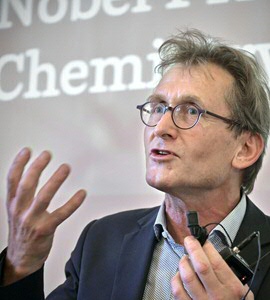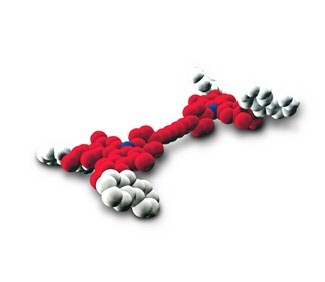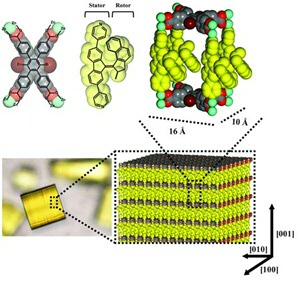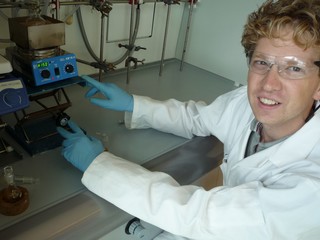Molecular motors and switches

Three years ago, University of Groningen chemistry professor Ben Feringa received the Nobel Prize for his work on molecular motors. These are tiny machines with a size of no more than a few billionth of a meter. Our cells are in fact full of complicated molecular motors and Feringa used these as an inspiration to create synthetic molecular motors that can move continuously in one direction. After winning the Nobel Prize, Feringa traversed the globe, giving lectures on his work and sharing his vision for science. But what interesting research did his group produce since the autumn of 2016?
The discovery of a molecular motor was something of an accident. In the late 1990s, Feringa was working with molecules that could switch from one form to another when triggered by light. He then discovered that one of these synthetic molecular switches rotated in one direction when exposed to light (and heat): a unidirectional rotary motor . Since light causes these motors and switches to reversibly change form and thus control their activity, it offers the potential to create a dynamic molecular system.

Nano car
The first light-driven rotary motor formed the foundation for the Nobel Prize-winning work. Building on this, Feringa created various molecular motors and switches powered by light of different colours. His most iconic construction is the molecular nanocar . This car, just a few nanometres long, could drive along a copper surface, powered by electrons delivered from the tip of a scanning tunnelling microscope. However, the car only operates in ultravacuum at 4 Kelvin (-269 degrees Celsius!) and needs a specially engineered ‘road’. As remarkable as this nanocar is, there are evidently some big challenges and a huge amount of work left to do before it can be used in the real world. Only recently, a PhD project dedicated to road engineering for nanocars was completed.

Motors in a gel
Working with simpler molecular switches does have its fair share of issues, one of which is Brownian motion, the random motion of particles resulting from collisions with surrounding fast-moving fluid molecules. This causes these nanosized motor molecules to continuously rotate in a random fashion. It is a real challenge to control their motion and put them to use. In one approach, switches or motors were put into gels , which reduced random motion. In other cases, motor molecules were immobilized on solid surfaces . In this way, motors and switches were capable of carrying out macroscopic work. A good example is the coordinated movement of motors placed inside a cage-like material (a metal-organic framework), which might be used to catalyse chemical reactions.
Artificial muscle
Another spectacular demonstration of this approach is the artificial muscle that the Feringa team made. They created fibres through self-assembly of light-sensitive motor molecules. The light will not penetrate the fibre and therefore affects only one side of it, causing it to bend. This is exemplified in a 2018 study, where hydrogel fibres that flexed like muscles could lift a weight of 0.4 milligrams, showing that molecular motors can perform work in the macroscopic world. This ability of motors to function in the macroscopic world also makes them interesting for the field of electronics. Switches have been developed that are not just sensitive to light but also to acid. A recent collaborative study (2019), led by University of Groningen assistant professor Ryan Chiechi, showed that these switches can be reversibly locked, which enables them to encode non-volatile information . Although at this stage this finding is just a proof of principle, it could eventually be implemented in logic and memory devices of the future.

Photo switches
So far, we have seen how useful the motors and switches can be in materials science and in electronics. However, they are also interesting for biology, as switches can alter the shape of a bioactive molecule and consequently its function. Feringa’s association with the use of photo switches in biology and medicine really took off in 2011. Much of the work in this arena has been done in collaboration with Wiktor Szymanski, who started his own group at the University Medical Center Groningen. In 2013, a seminal study was published in which the activity of an antibiotic was controlled by a photo switch . When overused, antibiotics increase bacterial resistance. Willem Velema, a PhD student of Feringa and Szymanski, came up with the idea to create antibiotics that do not work away from the location where they are required. He made antibiotics with an ‘on’ switch. Only when activated by UV light, the antibiotic would kill bacteria. When not exposed to light, it would switch off again – and thus the antibiotic would no longer be active.
However, these switches initially had several shortcomings. They had bulky hydrophobic cores, and were consequently not very soluble. Moreover, they were sensitive only to UV light, which is harmful to materials and tissues and will not penetrate deep into the body. There was a major breakthrough in 2017, in a study that presented the design of switches that were sensitive to infrared light . This type of light is not only harmless but also penetrates much deeper into tissues. These switches were subsequently incorporated into an antibiotic, trimethoprim. Upon exposure to red light, this antibiotic was switched on within two hours and showed a large increase in antimicrobial activity. However, the switching time needs to be reduced further to be of practical use.
Anti-cancer drug therapy
A similar path was followed to make use of switches in anti-cancer drug therapy. In 2019, the Szymanski group came up with a study on inhibitors for a class of enzymes called kinases, which are involved in around half the metastatic melanomas. In the field of pharmacology, it has been challenging to study kinases as they are present in large quantities and show great diversity in the body, which means that selective inactivation is difficult. This is problematic because kinase inhibitors can have serious side effects. To circumvent these problems, inhibitors with photo switches were designed that could be switched on and off with light. This would allow selective activation of the drug at its site of action, thereby reducing systemic drug activity. These studies pave a way for drug therapy in which damage to surrounding healthy tissues of the body can be minimized.
Left and right hand
Finally, back to the Feringa group. In one of their latest papers, they managed to create a special catalyst , based on the original motor molecule. Many important molecules, such as drugs, exist in two chemically identical forms that are each other’s mirror image, like a left hand and a right hand. These two ‘hands’ can have different properties: one may be the drug, while the other produces side effects. By using catalysts, chemists can produce just one type of ‘hand’. The special catalyst can be made to switch between two forms that will produce one or the other ‘hand’.
It is exciting to see such a widespread use of these molecules in various fields, building on the discoveries that brought Feringa the Nobel Prize. However, the research in pharmacology as well as the research in photoresponsive materials that was elaborated on above is still very fundamental in nature. These molecules require much further polishing and tuning before they are market-ready.
Written by Antara Mazumdar and René Fransen
Many thanks to Wiktor Szymanski and Wojtek Danowski for providing information on recent research into molecular motors and switches .
More news
-
27 November 2025
Aeroplane spotting using a radio telescope
-
26 November 2025
Why are shiny colours rare yet widespread in nature?
